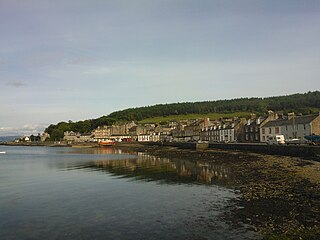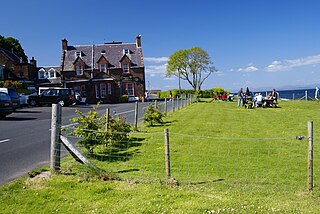
Argyll and Bute is one of 32 unitary authority council areas in Scotland and a lieutenancy area. The current Lord-Lieutenant for Argyll and Bute is Mrs Jane Margaret MacLeod. The administrative centre for the council area is in Lochgilphead at Kilmory Castle, a 19th-century Gothic Revival building and estate. The current Council leader is Aileen Morton.

The Firth of Clyde is the mouth of the River Clyde and the deepest coastal waters in the British Isles, sheltered from the Atlantic Ocean by the Kintyre peninsula which encloses the outer firth in Argyll and Ayrshire. The Kilbrannan Sound is a large arm of the Firth of Clyde, separating the Kintyre Peninsula from the Isle of Arran. Within the Firth of Clyde is another major island – the Isle of Bute. Given its strategic location, at the entrance to the middle/upper Clyde, Bute played a vitally important military (naval) role during World War II.

Dunoon is the main town on the Cowal peninsula in the south of Argyll and Bute, Scotland. It is located on the western shore of the upper Firth of Clyde, to the south of the Holy Loch and to the north of Innellan. As well as forming part of the council area of Argyll and Bute, Dunoon also has its own community council. Dunoon was a burgh until 1976.

Gourock is a town falling within the Inverclyde council area and formerly forming a burgh of the county of Renfrew in the West of Scotland. It has in the past functioned as a seaside resort on the East shore of the upper Firth of Clyde. Its principal function today, however, is as a popular residential area, extending contiguously from Greenock, with a railway terminus and ferry services across the Clyde.

Cowal is a peninsula in Argyll and Bute, in the west of Scotland, that extends into the Firth of Clyde.

The Holy Loch is a sea loch, a part of the Cowal peninsula coast of the Firth of Clyde, in Argyll and Bute, Scotland.

Port Bannatyne is a coastal village on the Isle of Bute, Firth of Clyde, Scotland. It is a popular harbour, with a small yacht marina and boatyard and an unusual 13-hole golf course.

Sandbank is a village on the Cowal peninsula in Argyll and Bute, Scotland. It is located 2.5 miles north of Dunoon on the coastal A815 or the inland A885 and sits on the southern shore of the Holy Loch, branching off the Firth of Clyde.

Innellan is a village on the east shore of the Cowal peninsula, on the Firth of Clyde, 4 miles south of the town of Dunoon, Argyll and Bute in Scotland.

Strone is a village, on the Cowal peninsula in Argyll and Bute in the Scottish Highlands at the point where the north shore of the Holy Loch becomes the west shore of the Firth of Clyde. The village lies within the Loch Lomond and The Trossachs National Park.

Corrie is a village on the north east coast of the Isle of Arran in Scotland, 6 miles north of Brodick. It lies 2 mi (3 km) due east under the island's highest mountain, Goat Fell. A path from High Corrie 3⁄4 mi (1.2 km) to the south, provides access to the hillside. Corrie, and its northern neighbour, Sannox, lie approximately halfway between Brodick and Lochranza.

Tighnabruaich; is a village on the Cowal peninsula, on the western arm of the Kyles of Bute in Argyll and Bute, Scotland. In 2011 the population was 660. It is west of Glasgow and north of the Isle of Arran.

Dunoon Grammar School is a secondary school in Dunoon, Cowal Peninsula, Argyll and Bute, Scotland. It was founded in 1641.

Ardnadam is a village on the Holy Loch on the Cowal peninsula, Argyll and Bute, Scotland. It is located northwest of Hunters Quay and east of Sandbank.

Hunters Quay is a village, on the Cowal peninsula in Argyll and Bute, Scottish Highlands. Situated between Kirn to the south and Ardnadam to the north, Hunters Quay is the main base of Western Ferries, operating between Hunters Quay and McInroy's Point.

Dunoon Castle is a ruined castle located at Dunoon on the Cowal peninsula in Argyll and Bute, Scotland. The castle sat upon a cone-shaped hill of about 80 feet high, a volcanic plug. Very little remains of the castle's structure today.

Dunoon Primary School is a school in Dunoon, Argyll and Bute, Scotland. It is located in a Category B listed building dating from 1901.

Loch Loskin; is a freshwater loch, on the outskirts of Dunoon on the Cowal peninsula, Argyll and Bute, West of Scotland. The outflow from the loch is the Milton Burn, which winds its way through Dunoon to the Firth of Clyde. The A885 from Sandbank known as the "High Road" locally passes the loch.

The Royal Marine Hotel is a hotel located on Marine Parade in Hunters Quay, Argyll and Bute, Scotland. It is a Category B listed building, opened in 1890 after the original 1856 building, named Marine Hotel, was gutted by fire. Its architect was Glasgow's Thomas Lennox Watson. The new construction received royal patronage in 1872.

Kirn & Sandbank Parish Church is a Church of Scotland church building in Kirn, Argyll and Bute, Scotland. It also serves the population of nearby Sandbank. The church is located on Kirn Brae at its junction with Marine Parade, which leads to and from Dunoon, about a mile to the southwest. Constructed in the Romanesque style, it is a Category B listed building.
























